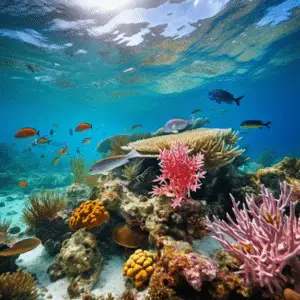The Florida Keys, a stunning archipelago off the southern coast of Florida, offers a mesmerizing underwater wonderland. This tropical paradise attracts divers and snorkelers worldwide with its crystal-clear turquoise waters and vibrant coral reefs. In this article, we will look closer at the captivating beauty of the coral reefs in the Florida Keys and the importance of preserving this fragile ecosystem.

The Florida Keys: A Tropical Archipelago
The Florida Keys is a string of islands that stretch approximately 120 miles from the southern tip of Florida. It consists of over 1,700 islands, mainly Key West, Key Largo, Islamorada, Marathon, and Big Pine Key. This region is renowned for its stunning beaches, abundant marine life, and, of course, its magnificent coral reefs.
The Importance of Coral Reefs
Coral reefs are visually striking and play a vital role in the ecosystem. They provide habitats for diverse marine species, protect coastlines from erosion, and even contribute to the local economy through tourism. Unfortunately, coral reefs worldwide face numerous threats, such as pollution, overfishing, and climate change, making their preservation crucial.
The Florida Keys Reef System
The Florida Keys Reef System, part of the larger Florida Reef Tract, is the third-largest coral reef ecosystem in the world. Spanning over 170 miles, it is home to an incredible variety of coral species, fish, and other marine organisms. This extensive reef system is divided into several distinct areas, each with unique characteristics.
Key Largo: Diving Capital of the World
Key Largo, the largest island in the Florida Keys, is often called the “Diving Capital of the World.” Its proximity to the continental shelf makes it an ideal location for novice and experienced divers to explore the vibrant reefs. The marine life here is diverse, with colorful coral formations and many fish species. Famous dive sites in Key Largo include Molasses Reef and the Christ of the Abyss statue, where divers can witness the beauty and wonder of the underwater world.
Islamorada: Snorkeler’s Paradise
Islamorada, known as the “Sport Fishing Capital of the World,” also boasts stunning coral reefs. With its clear waters and abundant marine life, this area offers an unforgettable snorkeling experience. Snorkelers can swim among vibrant coral gardens, spot schools of tropical fish, and even encounter gentle sea turtles. Popular sites in Islamorada include Alligator Reef and the Cheeca Rocks, known for their stunning coral formations and thriving marine ecosystems.
Marathon: Diverse Reef Formations
Marathon, situated in the heart of the Florida Keys, offers diverse reef formations. From shallow patch reefs to deeper, more intricate structures, divers and snorkelers can explore an enchanting underwater world. Sombrero Reef, a protected marine sanctuary, is a must-visit site in Marathon. It boasts a wide variety of corals, including elkhorn and staghorn corals. It provides a home to an array of colorful fish species.
Key West: Southernmost Underwater Paradise
Key West, the southernmost point of the continental United States, is renowned for its lively atmosphere and stunning sunsets. It also offers fantastic opportunities for diving and snorkeling. The Key West Marine Park, located just offshore, is home to fascinating coral formations and abundant marine life. Divers and snorkelers can explore the park’s diverse ecosystems, including seagrass beds, mangrove habitats, and coral reefs teeming with life.
The Magnificent Marine Life
The coral reefs of the Florida Keys are teeming with a remarkable array of marine life. Divers and snorkelers can witness the vibrant colors of tropical fish, graceful sea turtles gliding through the water, and even the occasional sighting of gentle manatees. The reefs are also home to various species of coral, including brain corals, fire corals, and delicate fan corals. Exploring these reefs allows visitors to witness firsthand the incredible biodiversity and the delicate balance of this marine ecosystem.
Conservation Efforts and Preservation
Recognizing the importance of preserving this natural treasure, various organizations, and government agencies are actively involved in conserving and protecting the coral reefs of the Florida Keys. Initiatives such as coral reef restoration, marine debris cleanup, and public awareness campaigns are helping to ensure the longevity of these fragile ecosystems for future generations. Visitors to the Florida Keys also have a role to play in protecting the coral reefs. Practicing responsible tourism, such as using reef-safe sunscreen, not touching or standing on the coral, and avoiding anchoring on reefs, can go a long way in preserving this fragile environment.

Conclusion
The coral reefs of the Florida Keys offer a glimpse into an underwater paradise. With their vibrant colors, diverse marine life, and unique geological formations, they provide a truly enchanting experience for divers and snorkelers. However, we must understand the fragility of these ecosystems and take active steps to protect them. By appreciating the beauty of the Florida Keys’ coral reefs while practicing responsible tourism, we can ensure that future generations will continue to marvel at the paradise under the sea.
